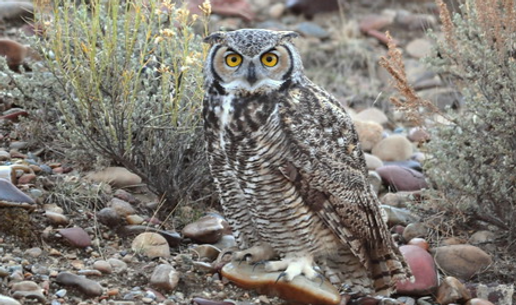Great Horned Owl
Bubo virginianus

Listen for deep hoots at night.
The great horned owl is a large, nocturnal bird of prey found throughout Arizona and much of the Americas. Recognizable by its prominent ear tufts, piercing yellow eyes, and deep, resonant hoot, it is a versatile and powerful hunter that preys on mammals, birds, and reptiles of varying sizes. This owl inhabits forests, desert edges, grasslands, and urban areas, often nesting in tree cavities, cliffs, or abandoned nests of other large birds. As a top nocturnal predator, the great horned owl plays a crucial role in controlling populations of small and medium-sized animals, while its haunting calls and silent flight make it one of the most iconic and easily recognized owls in Arizona.
Bird

Identification & Behavior
Key Features: Ear tufts, yellow eyes, powerful talons
Size: 18–25 in tall, 2–5.5 lbs
Behavior: Silent flyer, aggressive predator.
Diet: Carnivore — mammals, birds, reptiles
Activity Pattern: Nocturnal
Habitat & Distribution
Found statewide in Arizona, inhabiting forests, woodlands, deserts, riparian areas, and open grasslands. Often nests in tall trees, cliffs, or abandoned nests of other birds. Commonly observed near the Mogollon Rim, Kaibab Plateau, White Mountains, Verde Valley, and Sky Island ranges. Present in Coconino, Kaibab, Apache-Sitgreaves, Prescott, Tonto, and Coronado National Forests.
Elevation Range: 2,000–10,000 ft
Seasonal Presence: Year-round
Risks & Management
Avoid shining lights on nesting owls.




































